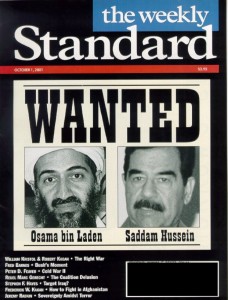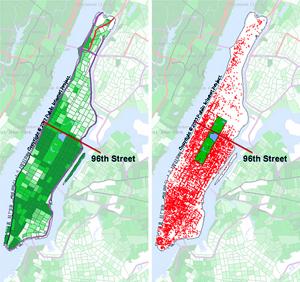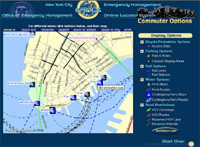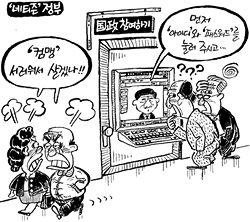www
Techniques of Electronic Advocacy
This entry has been updated and incorporated into An Introduction to Activism on the Internet.
I’ve been searching for a list of excellent examples of Internet activism. I couldn’t find one, so I made my own.
I’ve structured much of this list around categories outlined by Sasha Costanza-Chock in “Mapping the Repertoire of Electronic Contention,” in Representing Resistance: Media, Civil Disobedience and the Global Justice Movement, eds. Andrew Opel and Donnalyn Pompper. Greenwood, in press. Unless otherwise indicated, the quoted text below has been taken from him.
Though I’ve added some of my own commentary, this is not intended to be a full analysis of the campaigns and organizations mentioned. I disagree with the politics of many of the examples listed, but think there is something to be learned from each of the them.
Repurposing Payphones
The Washington Post reports on the demise of the payphone:
“In Washington, as in other parts of the country, pay phones are disappearing from the landscape. The number of them across the country has dwindled from a high of 2.7 million in the mid-1990s to about 1.9 million now, supplanted by the more personal wireless phones that fit in a pocket. The small companies that maintain them are pulling out of the business. Even at the higher price of 50 cents a call, many phones run at a deficit — it costs more to clean, maintain and service them — so people like [technician Andres] Castro are yanking them from their sockets, cutting the lines, and pulling them from shopping centers, gasoline stations, restaurants and street corners where they used to turn a booming profit.”
The Globe and Mail reports that instead of dismantling its pay phones, Bell Canada has started adding WiFi capabilities:
“Aimed at business customers, the service is free until late March and available at several sites in Montreal, Kingston, Ont., and Toronto. The project will also include service at Air Canada airport lounges in Calgary, Montreal, Toronto and elsewhere. The pilot project is intended to measure how customers use the service and how much to charge for it, although some observers wonder if service providers will be able to make much money from so-called wireless fidelity or wi-fi hot spots. For Bell’s hot-spot trial, it’s mostly setting up wi-fi nodes where it has payphones, effectively ‘reinventing’ the payphone business.”
In the United States, massive amounts of cash are being thrown at building a nationwide wireless infrastructure. Adding WiFi to payphones is picks up on an exisitng infrastructure. From Bell Canada’s press release:
“The plan calls for payphones in high traffic areas to be fitted with Wi-Fi technology; typical locations include airports, train stations, hotels, convention centers and corporate campuses.”
Adding WiFi to payphones would be a good way of brining WiFi to underserved neighborhoods — the same neighborhoods that rely on pay phones rather than cell phones.
From the Post again:
“It is much easier — and cheaper — to dial from a cell phone for customers who can afford one. However, pay phones are still profitable in the lowest-income areas of a city, said Terry Rainey, president of the American Public Communications Council Inc., an industry group representing independent pay phone operators around the country.
‘There are a great number of people in this country without a phone,’ Rainey said — 4 and 5 percent, which is more than the 1 or 2 percent of the U.S. population that lacks television sets.
‘Some lower-income areas rely on [pay phones] for regular communications, as well as, in some cases, emergency calls,’ said Mason Harris, president of Robin Technologies and of the Atlantic Payphone Association.”
Compare this map of median household income from the 1990 U.S. Census with this 2002 map of WiFi hotspots in Manhattan. From the Public Internet Project:
Click here for a larger version.
Update: On May 10, 2003, the New Jersey Star-Ledger reported that Verizon plans to put WiFi transmitters in pay phones across New York City. No mention of how much it will cost to use.
Also of note is this May 5 article from the International Herald Tribune which describes plans by the city of Paris to build a WiFi network along the subway system. Two or three antennas could be places outside each of Paris’s 372 Metro stations.
Data
From iaslash:
“The current media spectacle that is the ‘war on Iraq’ produces a lot of good and bad infographics. I was surfing the web looking for them and a few thoughts struck me:
Infographics are somewhat expensive and time-consuming to produce, and are therefore in their nature providing context to whatever is going on on the ground. It is, however, _not_ in their nature to provide afterthought and analysis.
The policy concerning infographics of NRK (Norwegian equivalent of the BBC) is that it is important to not overuse infographics because they can create the impression that this is a computer game and not real war with real people really being blown into little pieces.”
...
This MSNBC graphic on the number of U.S. and U.K. deaths in Iraq is an improvement on this chart
|
The maintainers of Iraqbodycount.net comb the media and publish an estimate of Iraqi casualties via a banner you can include on your Web page. A number of bloggers have picked it up, but the raw numbers, particularly in this layout, just read like a score.
On the flip side are the graphic photos of U.S. and Iraqi corpses [warning: strong content] you won’t see on CNN. The images overwhelm with horror.
Yet, to me neither are as heart rending as this list of names, ages, and U.S. hometowns.
The Visual Rhetoric of War

“The linking of the two evils. Unproven by the facts, reality in the image. The Wild West poster does the trick of validating the Bush approach and chosen iconography.”
The Better Rhetor builds on the work of Political Research Associates in this unpacking of the imagery used in a series of Weekly Standard covers.
See also Kate Brigham’s MFA thesis, Decoding Visual Language Elements in News Content, and its prototype Flash piece that allows you to alter design elements of post-September 11 news magazine spreads on the fly. See for yourself how non-verbal messages are expressed, the objectivity of the news is tilted, and the case for war is made by the choice of imagery, its cropping, composition, and color.
Thanks to drapetomaniac for the Better Rhetor link.
Rating Congressional Web sites
The Congress Online Project today posted their report on second annual report on congressional Web sites. The report:
- Briefly describes the methodology and process we used to evaluate all 610 congressional Member office, standing committee, and leadership Web sites;
- Provides a detailed assessment of the overall performance of these sites;
- Identifies the 75 best Web sites on Capitol Hill — the Congress Online Gold, Silver, and Bronze Mouse Award winners — which can serve as models for offices wishing to improve their own sites;
- Identifies five fundamental building blocks for effective Web sites — and explains how offices can incorporate them into their own sites; and
- Describes the mistakes congressional offices are making with their online practices.
Lots of useful info here, though I wonder why the authors would talk to citizens to develop the methdology of the study, but not as part of the actual analysis itself.
Routing
“New York City averted a public transit strike recently, saving commuters and residents a metropolitan-size headache of getting around. But if it had come to that, the city was ready to help idle people find their way.
A week before the scheduled strike, the city’s Office of Emergency Management, the Department of Information Technology and Telecommunications, and Frankfort, Ky.-based PlanGraphics Inc. designed and developed an interactive online map that enabled users to view various alternative transportation options and vehicular restrictions.
The application, which took about a half-day to design and a week to develop, was activated from Friday evening, Dec. 13, to Monday noon, Dec. 16, the deadline for the strike, said Mike Wiley, a project manager for PlanGraphics in New York City. During that time, users viewed more than 70,000 custom maps with a peak of about 6,000 maps served up Sunday evening. Although the application was subsequently deactivated, it’s available should a similar situation occur in the future.
The system can highlight bicycle and pedestrian access sites, carpool staging areas, rail lines and stations, ferry stops and routes, including contingencies, as well as carpool-only routes and other road restrictions.
The application is based on the city’s Emergency Management Online Locator System, which allows New Yorkers to find hurricane evacuation routes or cooling centers during a heat wave.
PlanGraphics, which has a seven-year working relationship with the city, also helped develop an online map of the area around the World Trade Center shortly after the Sept. 11, 2001, terrorist attacks. Sometimes twice daily, the company or the city would update what areas were accessible by motor vehicles or pedestrians in the area and provide other information.
The company is also planning to update the city’s “My Neighborhood Statistics” application, which allows users to view 14 selected performance statistics about their community, such as air and noise complaints, structural fires, infant mortality, clean sidewalks, felonies and certified teachers. By the end of January, the system, which went live in September 2002, will show 80 different metrics.
The city also recently awarded PlanGraphics a three-year, $15.4 million contract to continue to develop and upgrade the city’s GIS data repository, and provide greater access as well as more customized applications for the public and city agencies.”
Other non-interactive maps were posted, but the site vanished from the Web as quickly as it was posted.
MapQuest has driving instructions, Staphangers .org used to have a working subway route finder, and the Department of Transportation has PDF of NYC bicycle routes, but I’ve not found anything that ties together NYC’s many transportation alternatives into one online application.
In a struggle that shook the City, the Transport Workers Union stood up to the Mayor’s intimidation and successfully fought cuts. They also pushed the City into developing the most comprehensive New York City route finder I’ve seen. The screen shots I found indicate that the target audience were those who work in lower Manhattan and Wall Street, but such a tool would be useful for everyone — and would indicate which neighborhoods are underserved. I hope they put it back online, with subway and bus info added.
Update, 9/12/2003: The lack of a integrated route finding system in NYC has prompted one New York City resident to build his own. It needs work, but integrates bus and subway connections quite nicely.
Joe President
Joe Lieberman for President satire site.
Saw this a couple of weeks ago. Had a surprisingly hard time finding it again just now, so decided to link it here.
A faithfully mocking copy of the official site. They really nail the design and chatty tone, though I find the humor a bit obvious and the criticism rather dull. There’s so much more damning information in his voting record alone.
Graphic Designers Against the War in Iraq

“ANTI-WAR.US is dedicated to the free distribution of anti-war graphic material.
As creative individuals trained in methods of mass-communication, we can make a real difference by providing clear anti-war messages.
All materials on this site are created voluntarily and distributed free to activists around the world.”
A nice idea. I’m kicking myself for not thinking of it. Will send one of my own poster ideas shortly.
I do hope they will excercise some curatorial judgement, though. I’m a long-time admirer of Charles Wilkin’s design work. I’ve even used one of his fonts, but painting President Bush in the same league as Stalin and Hitler does not help the credibility of your cause.
via American Samizdat. Image above by M. Musri, Fabrica.
Korea’s Internet Election
In South Korea, it’s the mouse that roars
New breed of politician taps the country’s love affair with high tech
“The winning candidate in last week’s South Korean presidential election had little need for mass rallies or traditional campaign tactics.
When Roh Moo-hyun’s organizers wanted supporters to vote on election day, they simply pressed a few computer keys. Text messages flashed to the cellphones of almost 800,000 people, urging them to go to the polls.
During his campaign, millions of voters absorbed Mr. Roh’s message from Internet sites that featured video clips of the candidate and audio broadcasts by disc jockeys and rock stars. Half a million visitors logged on to his main Web site every day to donate money or obtain campaign updates. More than 7,000 voters a day sent him e-mails with policy ideas. Internet chat groups buzzed with debate on the election....
Almost half of South Korean voters are below the age of 40 — a prime demographic for users of the Internet and cellphones. Until this year, many were apathetic politically, put off by the country’s traditional political machinery. But Mr. Roh reached out to voters with one of the world’s most sophisticated Internet campaigns, and the vast majority of the younger population voted for him.
Until a year ago, Mr. Roh was best known for his repeated failures to be elected to parliament. Self-educated, he came from a poor family and had been jailed for helping dissidents fight the military regimes of the past. But young voters admired the lawyer for his integrity and his image as an independent outsider, and they formed an Internet fan club to promote his future.
The Internet allowed Mr. Roh to liberate himself from ‘black money’ — corporate donations that are South Korea’s traditional form of campaign financing. Largely through Internet-based campaign groups, Mr. Roh raised the equivalent of about $1-billion from more than 180,000 individual donors.”
I’m impressed by the apparent influence of the grassroots fan club site. And 7,000 users a day sent the guy policy ideas? It will be interesting to see how President Roh fulfills his promise “to use the Internet to make the government more open and transparent.”
Otherwise, though tech angle is interesting, the article totally takes it out of context. Who else was running? What issues were being discussed? Mr. Roh’s popularity is not just due to his “repeated failures to be elected to parliament” but to the fact that he repeatedly chose to run in districts where he knew he would lose in order to make a statement about the regional election machine. Many Koreans vote for candidates based primarily on what district they are from. Mr. Roh’s campaign runs were a principled stand against this.
Mr. Roh’s popularity is also due to the fact that he was a leader in the pro-democracy movement against the dictatorship of Chun Doo-hwan, was imprisoned for his political activism, and has a solid record as an advocate of human rights. As a lawyer he could have chosen a much more lucrative career instead of defending labor unions, students, and the poor. And, unlike his political rivals, wants to engage more with North Korea. (See the BBC’s profile.)
The real shock of the election is that a liberal candidate was elected after decades of conservative rule. In the past, the three powerful conservative newspapers have pushed hard against liberal candidates, for instance playing up skirmishes in the DMZ around election time to scare voters away from liberal candidates who might not be as tough on the North. In Korea, the “liberal” label has even more sting than in the U.S. Being associated with Communism in the press could end your political career.
But the younger generation does it have the same relationship to the War or the military dictatorship as the older generation. And the under-30 crowd seems to have less aversion to leftist ideas or engagement with the North. The relevance of the Internet is part of the generational and ideological shift of the voting population in Korea.
In addition to a few facts about the Internet in Korea, the Globe article is a lot like typical U.S. election reporting. All tactics, no substance. Who displayed the most charisma? How much did they spend? Who endorsed them? Meanwhile, the chat rooms in Korea are buzzing with debate. I look forward to the day when the decentralized, online discussion is as influential as our mainstream election coverage.
CarnivorePE
“CarnivorePE (Personal Edition) turns your computer into a personal data surveillance tool. Use CarnivorePE to run Carnivore clients from your own desktop, or use it to make your own clients. Read the FAQ, or view a screenshot of CarnivorePE in action with Mark Napier’s ‘Black and White’ client.”
 CarnivorePE is a packet sniffer designed by the “Radical Software Group” to emulate Carnivore one of the FBI’s email wiretapping systems (at least according to what we know about it.) CarnivorePE allows artists to translate traffic on a computer network into abstract visuals based on customizable filters.
CarnivorePE is a packet sniffer designed by the “Radical Software Group” to emulate Carnivore one of the FBI’s email wiretapping systems (at least according to what we know about it.) CarnivorePE allows artists to translate traffic on a computer network into abstract visuals based on customizable filters.
While CarnivorePE does call attention to Federal wiretapping and, to a degree, how insecure networks can be, I find it utterly complacent. The project actually makes no comment about data insecurity or FBI surveillence. Instead it takes it as a departure point, as a given, makes it pretty, and even wins cash and props (see the praise of the art press and the list of funders at the bottom of the page.) The project does practically nothing to educate users about Internet security or to encourage better security habits. The project does nothing to push for greater disclosure of government surveillence or greater restrictions. In fact, the equation seems to be that more surveillence means more pretty art.
Whether you go for the technical fix or the political one, there are more constructive ways to apply your technical and creative talents. Why not develop entertaining and easy to understand materials to teach about computer and Internet security, privacy, anonymity? Encourage the use of encryption? Take action in the campaign against the FBI’s use of Carnivore? Or join Project Vegan, an anti-Carnivore set of Free Software tools in much need of contributers?









